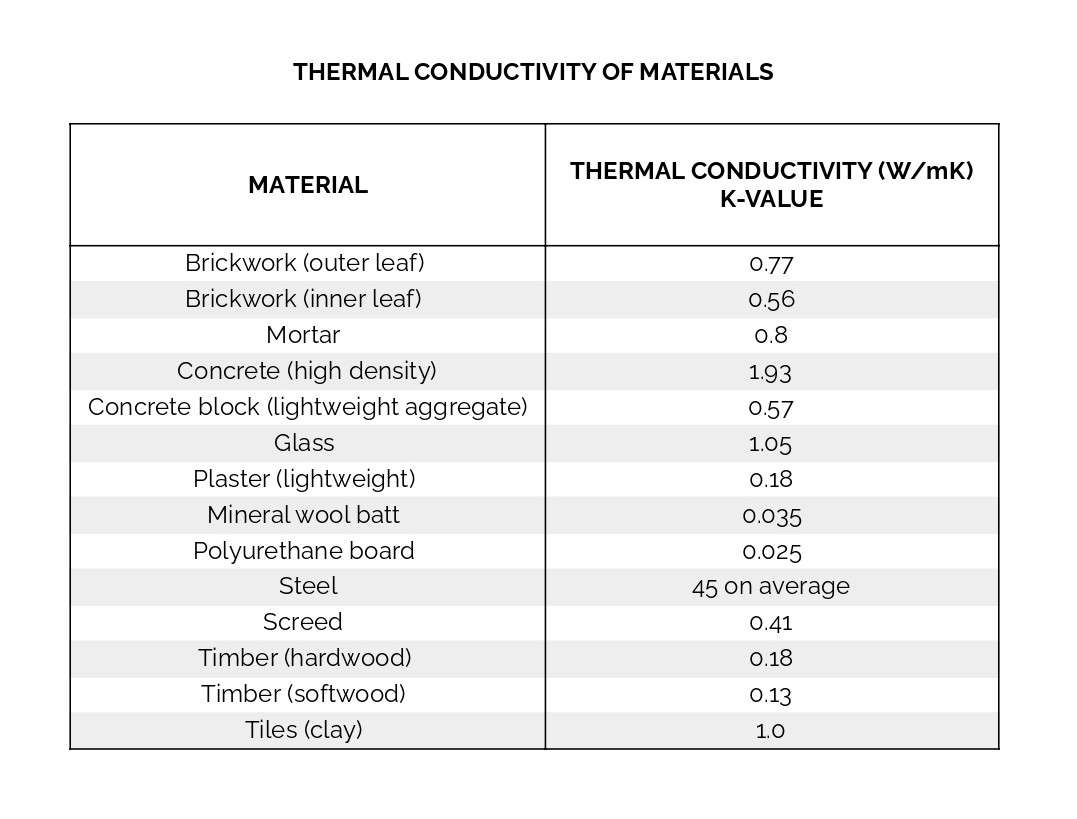The ubiquitous thermal conductivity of building materials table is a starting point, a snapshot in time, but it rarely tells the whole story. It’s easy to get lost in the numbers, comparing concrete to wood, or brick to insulation, using these tables as gospel. However, the real-world performance of a building material is far more nuanced and influenced by factors rarely acknowledged in a simple chart. Understanding these subtleties is crucial for architects, engineers, and homeowners alike, ensuring energy efficiency and comfort within the built environment, and ultimately moving beyond the limitations of just a thermal conductivity of building materials table.
Factors Influencing Thermal Conductivity: A Deeper Dive
While a table presents a specific value, several factors can significantly alter the actual thermal conductivity of a building material:
- Moisture Content: Water is a highly conductive material compared to air. Increased moisture within a material, such as wood or insulation, dramatically increases its thermal conductivity.
- Density: Denser materials generally exhibit higher thermal conductivity. For example, high-density concrete will conduct heat more readily than lightweight concrete.
- Temperature: Thermal conductivity is often temperature-dependent. The value listed in a table might be at a specific temperature, which may not reflect the actual operating temperature.
- Material Age and Degradation: Over time, building materials can degrade, altering their composition and affecting their thermal properties. Insulation can compress, reducing its effectiveness, while wood can decay, increasing its thermal conductivity.
Beyond Static Values: Dynamic Performance
The static values presented in a thermal conductivity of building materials table fail to capture the dynamic nature of heat transfer in real buildings. Consider these points:
- Orientation and Exposure: The amount of solar radiation a building material receives significantly impacts its temperature and heat transfer. A south-facing wall will behave differently than a north-facing wall.
- Airflow and Ventilation: Air movement around and through building materials can dramatically affect heat loss or gain. A poorly sealed window can negate the benefits of even the best insulation.
- Material Combinations and Assemblies: The overall thermal performance of a wall or roof assembly depends on the interaction of all the materials involved, not just the individual thermal conductivities. Thermal bridging, where highly conductive materials create pathways for heat flow, can significantly reduce overall insulation effectiveness.
R-Value vs. U-Value: A Crucial Distinction
Understanding the difference between R-value (thermal resistance) and U-value (thermal transmittance) is critical. R-value represents the resistance to heat flow through a specific thickness of a material, while U-value represents the rate of heat transfer through an entire assembly. Lower U-values and higher R-values indicate better insulation performance.
Moving Towards Holistic Building Design
To design truly energy-efficient buildings, we must move beyond relying solely on a thermal conductivity of building materials table. We need to consider the dynamic interactions of materials, the effects of environmental factors, and the overall building design. Sophisticated modeling software and on-site testing can provide a more accurate picture of thermal performance. The next step is to build better models to show how these materials can be implemented in buildings.
Finally, the ultimate goal is to create comfortable, sustainable buildings that minimize energy consumption. For this to happen, we must look at the whole picture, and, only then, use a thermal conductivity of building materials table as one of many tools.
Therefore, embrace a holistic approach. Prioritize airtightness and proper ventilation. Consider the embodied energy of materials – the energy required to extract, manufacture, and transport them. Opt for locally sourced materials whenever possible to minimize transportation emissions. Explore innovative materials and construction techniques that offer superior thermal performance and environmental benefits.
RECOMMENDATIONS FOR INFORMED MATERIAL SELECTION
Instead of blindly trusting a single number, adopt these best practices for material selection:
– Consult with a Building Science Professional: Engage an expert who can assess your specific project requirements and recommend appropriate materials and construction techniques.
– Review Material Certifications and Standards: Look for materials that meet recognized industry standards for thermal performance and durability.
– Consider Life Cycle Cost Analysis: Evaluate the long-term costs associated with a material, including energy consumption, maintenance, and replacement.
– Demand Transparency from Manufacturers: Request detailed information about the thermal properties of materials, including testing data and performance specifications under various conditions.
– Conduct On-Site Testing: Where feasible, perform on-site testing to verify the actual thermal performance of materials and assemblies.
EMBRACING INNOVATION IN BUILDING MATERIALS
The building materials industry is constantly evolving, with new and improved products emerging regularly. Stay informed about the latest advancements in insulation, glazing, and other building components. Consider exploring options such as:
– Vacuum Insulation Panels (VIPs): Offer exceptional thermal resistance in a thin profile, ideal for space-constrained applications.
– Aerogels: Lightweight and highly insulating materials derived from gels.
– Phase Change Materials (PCMs): Absorb and release heat, helping to regulate indoor temperatures.
– Bio-Based Materials: Such as hempcrete and straw bales, offer sustainable alternatives to conventional building materials.
THE FUTURE OF BUILDING PERFORMANCE
The future of building design lies in creating intelligent, responsive structures that adapt to their environment. By embracing a holistic approach to material selection, prioritizing energy efficiency, and embracing innovation, we can create buildings that are not only comfortable and sustainable but also contribute to a healthier planet. Remember, a single table can’t tell the whole story; it’s the thoughtful integration of materials and design that truly makes a difference.
In conclusion, while handy, the thermal conductivity of building materials table should be viewed as a starting point for a more considered and comprehensive evaluation of building material properties and their impact on the overall performance of a building. Prioritize real-world data and adapt your thinking to suit the project in hand.







